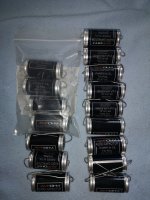For sale 4 pieces of this top pio tin foil caps 0,1uf value. They are nos in top condition. They not more in production.
Price 100eu plu shipping!! Test from enjoythemusic:
So it came to me as a pleasant surprise when the AmpOhm Tin PIO directly replaced Mundorf SIO and seemed to be sounding at least as good! From experience, I knew oil caps need to settle in the specific circuit through regular use, so I let AmpOhm play/turn-off for many days.
AmpOhm really seems to hit the right balance among PIO's. In some circuits, the wonderful Jensen copper PIO can sometimes sound a bit too refined and buttery for my tastes, but AmpOhm avoids that while still remaining smooth. Speaking of smooth, AmpOhm is smoother than the Russian K40y, which in comparison can seem to have slightly more prominent grain-structure. Mundorf SIO is not paper-in-oil, and as such, it has more top-end "air" and speed compared to most true PIO's. AmpOhm does not necessarily make you notice that extra air and sparkle up top, but it's still very extended when one listens for acoustic instruments like bells and triangles. What it has over Mundorf is higher density of tone and richness while not sounding syrupy or slow.
I still remember the first time I played Bach Cello Suites via AmpOhm. The cello sounded so magnificent I almost fell off my chair! Every detail, texture came through with power and vigor. They are much larger than similar-value Mundorf SIO, so make sure you have enough space, but they are very well-built, look beautiful, and sound even better. One caution. If you are looking to PIO's as sort of a filter to hide system faults by rounding, glossing-over, or rolling-off, these AmpOhms are not the way to go because they are still incredibly detailed and revealing of the signal chain.
Price 100eu plu shipping!! Test from enjoythemusic:
So it came to me as a pleasant surprise when the AmpOhm Tin PIO directly replaced Mundorf SIO and seemed to be sounding at least as good! From experience, I knew oil caps need to settle in the specific circuit through regular use, so I let AmpOhm play/turn-off for many days.
AmpOhm really seems to hit the right balance among PIO's. In some circuits, the wonderful Jensen copper PIO can sometimes sound a bit too refined and buttery for my tastes, but AmpOhm avoids that while still remaining smooth. Speaking of smooth, AmpOhm is smoother than the Russian K40y, which in comparison can seem to have slightly more prominent grain-structure. Mundorf SIO is not paper-in-oil, and as such, it has more top-end "air" and speed compared to most true PIO's. AmpOhm does not necessarily make you notice that extra air and sparkle up top, but it's still very extended when one listens for acoustic instruments like bells and triangles. What it has over Mundorf is higher density of tone and richness while not sounding syrupy or slow.
I still remember the first time I played Bach Cello Suites via AmpOhm. The cello sounded so magnificent I almost fell off my chair! Every detail, texture came through with power and vigor. They are much larger than similar-value Mundorf SIO, so make sure you have enough space, but they are very well-built, look beautiful, and sound even better. One caution. If you are looking to PIO's as sort of a filter to hide system faults by rounding, glossing-over, or rolling-off, these AmpOhms are not the way to go because they are still incredibly detailed and revealing of the signal chain.
Attachments
Bump!! Only for left from this top pio capacitors tin foil. Two of them have verry slight dent, but working perfectly, all are new and Nos. Price for all 4 pieces 50 euro including shipping to EU!! Payment paypal.
